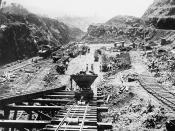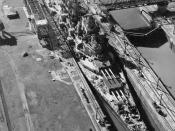In 1825, a group of American businessmen announced the formation of a new canal building company, with interests in constructing the first canal system across the Isthmus. This project was to take place in an area that we now called Panama. The endeavor was filled with controversy. Though the canal itself was not built until the early 1900's every step toward the building and ownership, was saturated with difficulty. The construction of the canal would not be easy, the French made an attempt and failed. Workers had to deal with mosquito infestation, terrible mud slides, and also the malaria virus.
In 1878 Ferdinand de Lesseps, the French engineer who built the Suez canal began work on a canal, on the same site as todays Panama Canal. The outbreak of tropical disease and engineering problems soon halted all construction on the canal, but a French business still held the rights to the project .
The United states acquired the rights to the area for a payment of 40 million dollars to the French, and 10 million to the Panamanians, and also a guarantee for Panamas independence. Soon after America had full control of what is today called the "canal zone" , President Roosevelt ordered thousands of army workers to begin work on the canal, and realized that this would be no easy task.
The Panama Canal joins the Atlantic and Pacific oceans. It runs from
Cristobal on Lemon bay, a part of the Caribbean sea, to Balboa, on the
Gulf of Panama. The canal is slightly more than 64 km long, and this does not include the dredged approach channels at either end. It takes about 9 days to complete the journey through all 51 miles of the canal, but on a trip from New York Harbor to San Francisco...



Not bad
a few small mistakes, having to do wiht spacing at the time it was submitted, but if those r deleted its a great essay
1 out of 1 people found this comment useful.